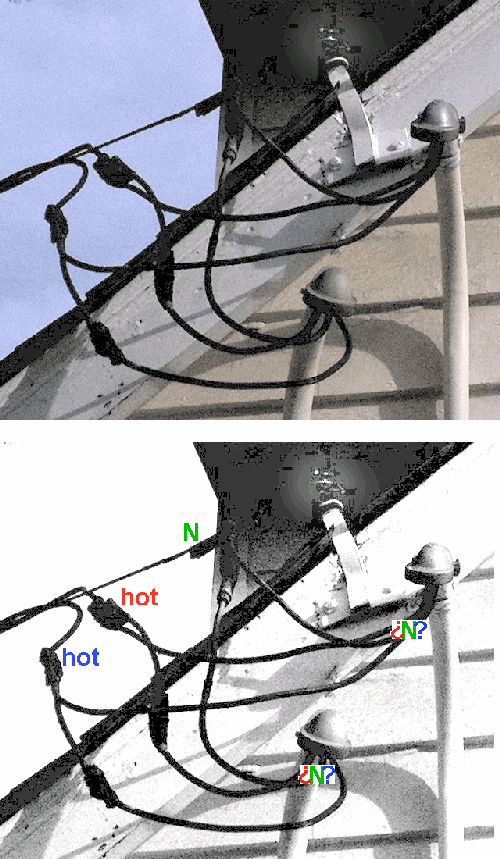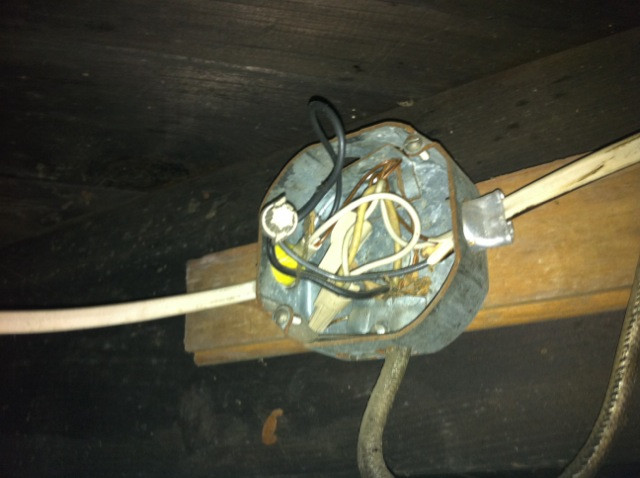0dbfs
Well-known member
I've moved into a new house recently and just discovered some electrical issues as a result of letting the smoke out of some gear. Luckily it was just gear and not my wife, son, or myself that the smoke came out of.
I measure 120V between two different GND prongs on different outlets yet my "plug-checker" shows that each outlet is correct.
Additionally, each of these two outlets measure 120V between line&neutral, line&gnd, and 0V between gnd&neutral.
Here's some more measurements:
---- SNIP ----
L1, N1, G1 = Line, Neutral, GND circuit #1
L2, N2, G2 = Line, Neutral, GND circuit #2
L1 to G1 = 125V
L1 to N1 = 125V
G1 to N1 = 0.xxV
L2 to G2 = 123V
L2 to N2 = 123V
G2 to N2 = 0.xxV
N2 to N1= 123V!
G2 to G1 = 123V!
N2 to G1 = 123V!
L1 to L2 = 123V
L1 to N2 = 0.xxV
L1 to G2 = 0.xxV
L2 to N1 = 0.xxV
L2 to G1 = 0.xxV
---- SNIP ----
Basically, when I patch some audio I/O's together that are connected to the different electrical circuits I get 120V flowing between the GND's which would also be present between the two chassis!
Fortunately, this caused the smoke to come out of a nice expensive piece. That however can be replaced.
Any ideas on how to localize and correct this fault?
Is this a symptom of having different phases on different circuits? I wouldn't think so because the L & G's shouldn't be affected by the phase of the L. or should they?
We do have two services hooked up to the house due to a renovation and "adding" an apartment at some point in the past. So these circuits are probably connected up to different services.
Should I call the electric company? An electrician?
It's not our house so I can let the owner know but regardless of that this is a huge safety issue that probably affects different circuits in the house that I have not yet identified and I need to get it fixed asap. Plus, I can't have my gear or others gear smoking like this.
Help is much appreciated!
Best,
jonathan
I measure 120V between two different GND prongs on different outlets yet my "plug-checker" shows that each outlet is correct.
Additionally, each of these two outlets measure 120V between line&neutral, line&gnd, and 0V between gnd&neutral.
Here's some more measurements:
---- SNIP ----
L1, N1, G1 = Line, Neutral, GND circuit #1
L2, N2, G2 = Line, Neutral, GND circuit #2
L1 to G1 = 125V
L1 to N1 = 125V
G1 to N1 = 0.xxV
L2 to G2 = 123V
L2 to N2 = 123V
G2 to N2 = 0.xxV
N2 to N1= 123V!
G2 to G1 = 123V!
N2 to G1 = 123V!
L1 to L2 = 123V
L1 to N2 = 0.xxV
L1 to G2 = 0.xxV
L2 to N1 = 0.xxV
L2 to G1 = 0.xxV
---- SNIP ----
Basically, when I patch some audio I/O's together that are connected to the different electrical circuits I get 120V flowing between the GND's which would also be present between the two chassis!
Fortunately, this caused the smoke to come out of a nice expensive piece. That however can be replaced.
Any ideas on how to localize and correct this fault?
Is this a symptom of having different phases on different circuits? I wouldn't think so because the L & G's shouldn't be affected by the phase of the L. or should they?
We do have two services hooked up to the house due to a renovation and "adding" an apartment at some point in the past. So these circuits are probably connected up to different services.
Should I call the electric company? An electrician?
It's not our house so I can let the owner know but regardless of that this is a huge safety issue that probably affects different circuits in the house that I have not yet identified and I need to get it fixed asap. Plus, I can't have my gear or others gear smoking like this.
Help is much appreciated!
Best,
jonathan





